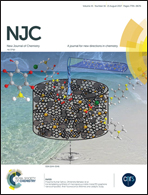Organic matrix-induced formation of a discrete cyclic [Cl2(H2O)2]2− cluster†
Abstract
Reaction of N-thiophosphorylated thiourea 6-NH2-Py-2-NHC(S)NHP(S)(OiPr)2 (L) with N,N'-dimethylformamide azine dihydrochloride (DMFA·2HCl) leads to the formation of a co-crystallization product of 2,6-di(4H-1,2,4-triazol-4-yl)pyridine and 2,6-diaminopyridinium chloride monohydrate (1) as well as bis-triazole N-(diisopropoxythiophosphoryl)-N'-(6-(4H-1,2,4-triazol-4-yl))pyridin-2-ylthiocarbamide (2), which can be separated by fractional precipitation. The crystal structure analysis of 1 shows the formation of a tetrameric cyclic secondary building unit (SBU) because of the formation of intermolecular hydrogen bonds by bis-triazole molecules and dipyridinium cations. The cavity of the cyclic tetramer is occupied by a rhombohedral cyclic [Cl2(H2O)2]2− cluster. The SBU is further connected to neighboring SBUs by a number of intermolecular hydrogen bonds, forming a 3D structure. Hirshfeld surface analysis showed that the structure of the [Cl2(H2O)2]2− cluster is almost fully characterized by highly favourable Cl⋯H and O⋯H intermolecular contacts as well as by less favourable H⋯H contacts. The former two contacts are also highly favourable in the structures of 2,6-di(4H-1,2,4-triazol-4-yl)pyridine and 2,6-diaminopyridinium, although their contribution on the molecular surface is remarkably impoverished. The dominant and favourable contacts, however, on the Hirshfeld surface area of these two organic species are H⋯H, H⋯N and H⋯C. The isolated thiourea 2 is considered as a promising coordination chemistry precursor due to a number of different possible coordination sites.
![Graphical abstract: Organic matrix-induced formation of a discrete cyclic [Cl2(H2O)2]2− cluster](/en/Image/Get?imageInfo.ImageType=GA&imageInfo.ImageIdentifier.ManuscriptID=C7NJ00700K&imageInfo.ImageIdentifier.Year=2017)


 Please wait while we load your content...
Please wait while we load your content...